Discover Simple Indian Vegetarian Recipes for Dinner That Delight
Dinner time can often feel like a daunting task, especially after a long day. However, when you bring the rich flavors of Indian cuisine to your table, dinner transforms into an exciting culinary adventure. Indian cuisine is celebrated for its vibrant colors, aromatic spices, and diverse ingredients, making it a treasure trove of vegetarian recipes that are both satisfying and nutritious.
In this article, I will share a collection of simple Indian vegetarian recipes that are perfect for dinner. Whether you are a seasoned chef or a beginner in the kitchen, these recipes will not only nourish your body but also delight your taste buds. From hearty curries to fragrant rice dishes, you’ll find an array of options that fit any occasion. So, roll up your sleeves and let’s dive into the vibrant world of Indian vegetarian cooking!
Key Aspects of Simple Indian Vegetarian Recipes for Dinner
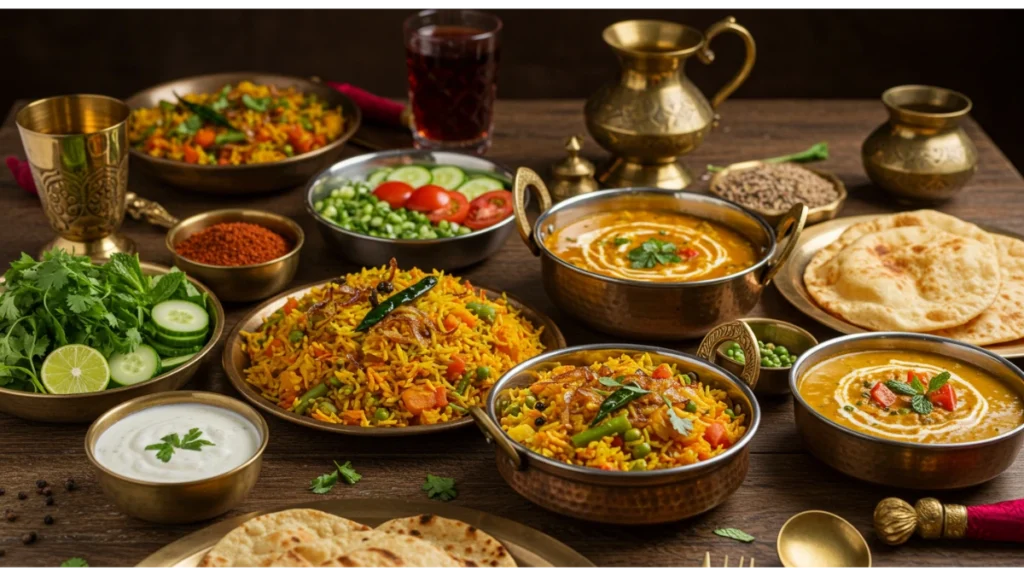
Indian cuisine is a beautiful amalgamation of flavors, textures, and colors. At its core, vegetarian cooking in India is about using fresh, seasonal ingredients and a variety of spices that not only enhance the taste but also contribute to the health benefits of the dishes. Here are some key aspects that define simple Indian vegetarian recipes:
- Diverse Ingredients:
Indian vegetarian recipes often include a wide range of vegetables, legumes, grains, and dairy products. Staples like lentils (dal), chickpeas, and a variety of greens are commonly used, providing essential nutrients and proteins. - Spice Palette:
The essence of Indian cuisine is beautifully captured in its diverse array of spices. Common spices such as cumin, coriander, turmeric, and garam masala are used to create depth and complexity in the dishes. Understanding how to use these spices can elevate even the simplest of recipes. - Cooking Techniques:
Indian cooking employs various techniques, including sautéing, steaming, and slow cooking. These methods help to retain the flavors and nutritional value of the ingredients while allowing the spices to meld beautifully. - Regional Variations:
Each region in India has its own unique culinary traditions, leading to a rich diversity of vegetarian recipes. From the creamy paneer dishes of North India to the coconut-infused curries of South India, there’s something for everyone. - Health Benefits:
Vegetarian meals are inherently rich in fiber, vitamins, and minerals. Many Indian vegetarian recipes are also low in fat and can be easily adapted to suit various dietary needs, making them a healthy choice for dinner.
Ingredients You’ll Need for Simple Indian Vegetarian Recipes
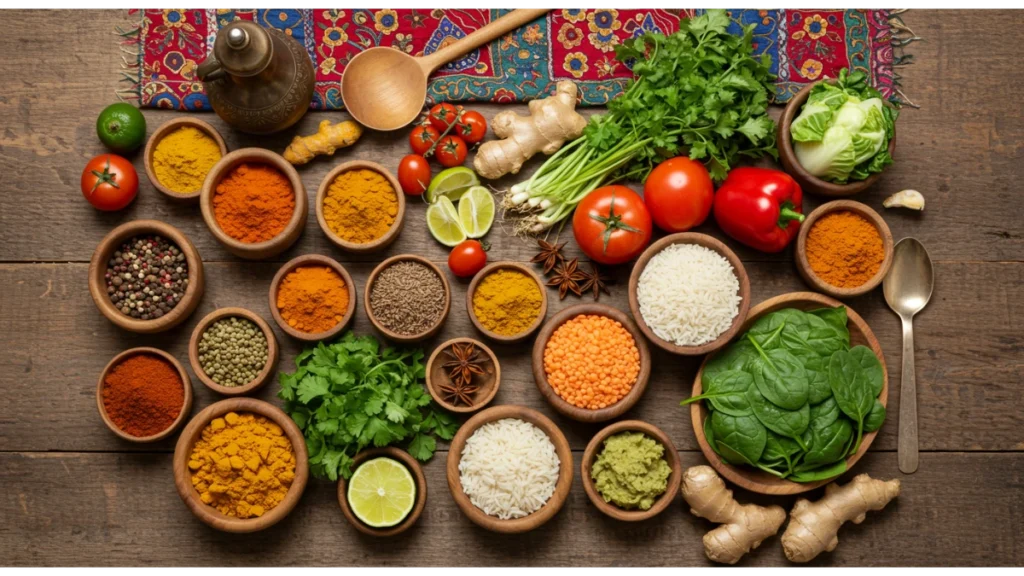
To prepare these delightful Indian vegetarian recipes, you will typically need the following ingredients. These staples are essential in most Indian kitchens and can be easily sourced from local grocery stores or Indian markets.
- Lentils (Dal):
Lentils are a primary source of protein in vegetarian diets. Common varieties include red lentils (masoor dal), split yellow lentils (moong dal), and black lentils (urad dal). - Rice:
Basmati rice is the most popular choice for Indian dishes, known for its fragrant aroma and fluffy texture. Other varieties like jasmine rice or brown rice can also be used. - Vegetables:
A variety of vegetables can be used, including potatoes, carrots, peas, spinach, cauliflower, and bell peppers. Seasonal vegetables add freshness and flavor to your dishes. - Spices:
Essential spices include cumin seeds, coriander powder, turmeric powder, garam masala, and chili powder. Fresh spices enhance flavor and aroma. - Fresh Herbs:
Fresh cilantro (coriander leaves) and mint are commonly used to garnish dishes and add a burst of freshness. - Dairy Products:
Ghee (clarified butter) is often used for cooking, while yogurt is served as a side dish or used in marinades. Paneer (Indian cottage cheese) is also a popular ingredient in many vegetarian recipes. - Cooking Oils:
Vegetable oil, mustard oil, or ghee are commonly used for sautéing and frying. - Other Essentials:
Onions, garlic, and ginger are foundational ingredients that add depth to Indian dishes. Tomatoes are often used in curries and gravies for a rich base.
Step-by-Step Instructions to Make Simple Indian Vegetarian Recipes
Here, I will provide a selection of simple Indian vegetarian recipes that are perfect for dinner. Each recipe includes a list of ingredients, step-by-step instructions, and tips to ensure success.
1. Vegetable Biryani
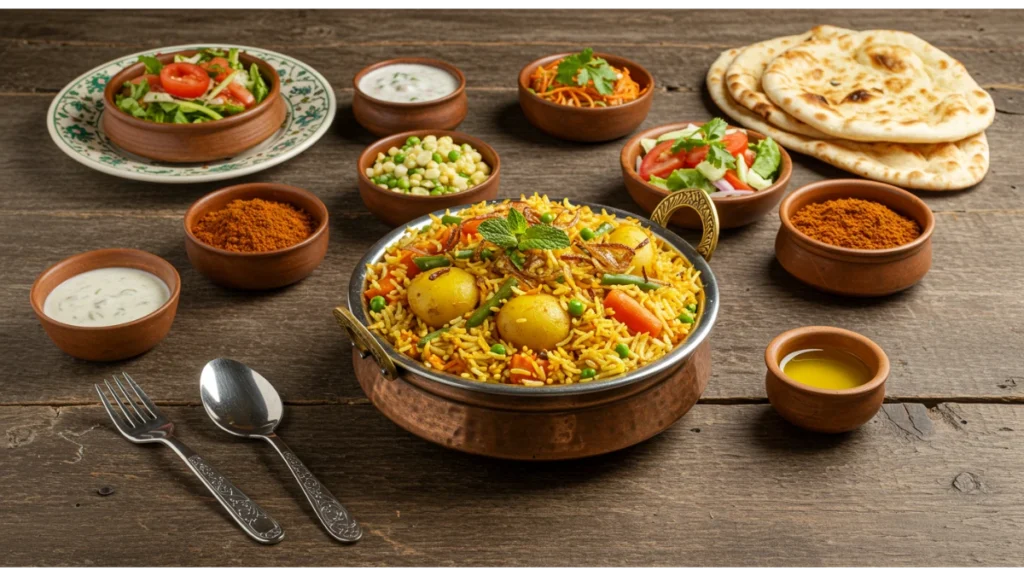
Ingredients:
- 2 cups basmati rice
- 1 cup mixed vegetables (carrots, peas, beans, and potatoes)
- 1 large onion, thinly sliced
- 2 tomatoes, chopped
- 2-3 green chilies, slit
- 1 teaspoon ginger-garlic paste
- 2-3 tablespoons biryani masala
- 1/4 cup fresh mint leaves, chopped
- 1/4 cup fresh cilantro, chopped
- 4 cups water
- 2 tablespoons ghee or oil
- Salt to taste
Instructions:
- Thoroughly wash the basmati rice under cold water until it runs clear. Soak it for 30 minutes, then drain.
- In a large pot, warm ghee or oil over medium heat. Add sliced onions and sauté until golden brown.
- Add ginger-garlic paste and green chilies. Sauté for a minute until fragrant.
- Add the chopped tomatoes and sauté until they soften.
- Stir in the mixed vegetables and biryani masala. Cook for 5 minutes, stirring occasionally.
- Add the soaked and drained rice, mint leaves, cilantro, and salt. Gently mix everything.
- Once it reaches a boil, lower the heat, cover, and let it simmer for 15-20 minutes until the rice is fully cooked and the water has been absorbed.
- Fluff the biryani with a fork and let it rest for 5 minutes before serving.
Tips:
- For added flavor, you can include whole spices like bay leaves, cardamom, and cloves while cooking the biryani.
- Serve with raita (yogurt sauce) or salad for a complete meal.
2. Palak Paneer
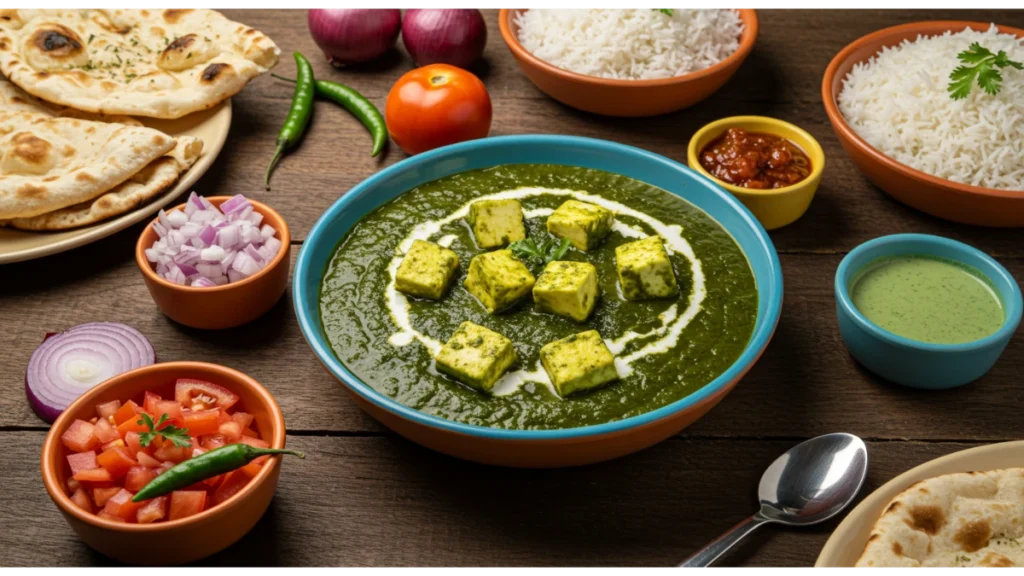
Ingredients:
- 250 grams paneer, cubed
- 2 cups spinach leaves, washed and chopped
- 1 large onion, chopped
- 2 tomatoes, chopped
- 1 teaspoon ginger-garlic paste
- 1-2 green chilies, slit
- 1/2 teaspoon cumin seeds
- 1/2 teaspoon turmeric powder
- 1/2 teaspoon garam masala
- 2 tablespoons oil or ghee
- Salt to taste
- Fresh cream (optional, for garnish)
Instructions:
- Blanch the spinach leaves in boiling water for 2-3 minutes, then transfer them to ice-cold water to retain the green color. Drain and blend into a smooth puree.
- In a skillet, warm the oil or ghee over medium heat. Add cumin seeds and let them splutter.
- Add chopped onions and sauté until golden brown. Next, incorporate the ginger-garlic paste and green chilies, sautéing for an additional minute.
- Stir in the chopped tomatoes, turmeric powder, and salt. Cook until the tomatoes break down and the oil begins to separate.
- Add the spinach puree and cook for 5-7 minutes, stirring occasionally.
- Add the paneer cubes and garam masala. Stir gently to coat the paneer with the spinach mixture. Cook for an additional 5 minutes.
- Garnish with fresh cream if desired and serve hot with roti or naan.
Tips:
- For a richer flavor, you can sauté the paneer cubes in a little ghee before adding them to the curry.
- Adjust the spice level by increasing or decreasing the amount of green chilies.
3. Chana Masala
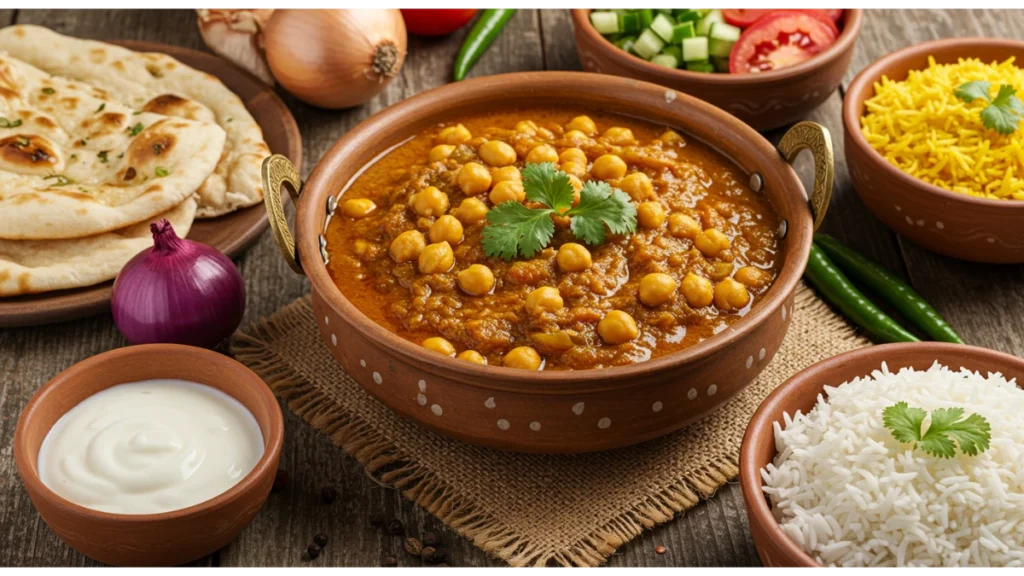
Ingredients:
- 1 cup chickpeas (canned or soaked overnight and boiled)
- 1 large onion, finely chopped
- 2 tomatoes, chopped
- 1-2 green chilies, slit
- 1 teaspoon ginger-garlic paste
- 1 teaspoon cumin seeds
- 1 teaspoon coriander powder
- 1/2 teaspoon cumin powder
- 1/2 teaspoon turmeric powder
- 1/2 teaspoon garam masala
- 2 tablespoons oil
- Salt to taste
- Fresh cilantro for garnish
Instructions:
- Warm oil in a pan over medium heat. Add cumin seeds and let them splutter.
- Add chopped onions and sauté until golden brown. Then add ginger-garlic paste and green chilies, sautéing for an additional minute.
- Stir in chopped tomatoes and cook until they soften.
- Add coriander powder, cumin powder, turmeric powder, and salt. Mix well and cook for 2-3 minutes.
- Add the boiled chickpeas and 1 cup of water. Stir well and simmer for 10-15 minutes, allowing the flavors to meld.
- Sprinkle garam masala on top and garnish with fresh cilantro before serving.
Tips:
- Serve chana masala with steamed rice, bhature, or naan for a complete meal.
- You can add a splash of lemon juice for a tangy flavor.
4. Aloo Gobi
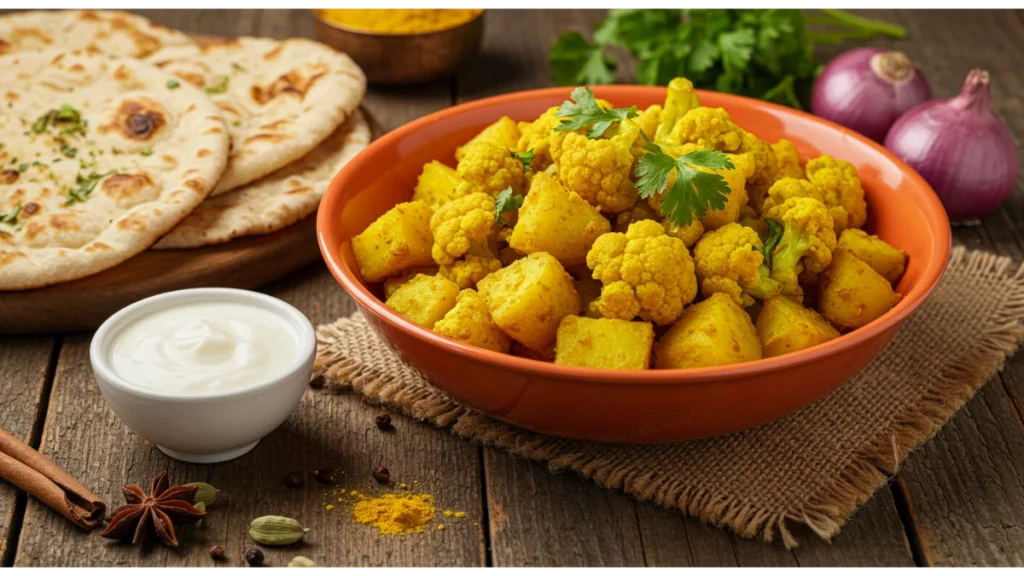
Ingredients:
- 2 medium potatoes, diced
- 1 small cauliflower, cut into florets
- 1 large onion, sliced
- 1 teaspoon ginger-garlic paste
- 1 teaspoon cumin seeds
- 1/2 teaspoon turmeric powder
- 1 teaspoon coriander powder
- 1/2 teaspoon garam masala
- 2 tablespoons oil
- Salt to taste
- Fresh cilantro for garnish
Instructions:
- Heat oil in a pan over medium heat. Add cumin seeds and let them splutter.
- Add sliced onions and sauté until golden brown. Next, incorporate the ginger-garlic paste and green chilies, sautéing for an additional minute.
- Stir in diced potatoes and cauliflower florets. Add turmeric powder, coriander powder, and salt. Mix well to coat the vegetables with spices.
- Cover the pan and cook on low heat for 15-20 minutes, stirring occasionally until the vegetables are tender.
- Once cooked, sprinkle garam masala on top and garnish with fresh cilantro before serving.
Tips:
- For added flavor, you can include peas or carrots in this dish.
- Serve with chapati or paratha for a wholesome meal.
5. Dal Tadka
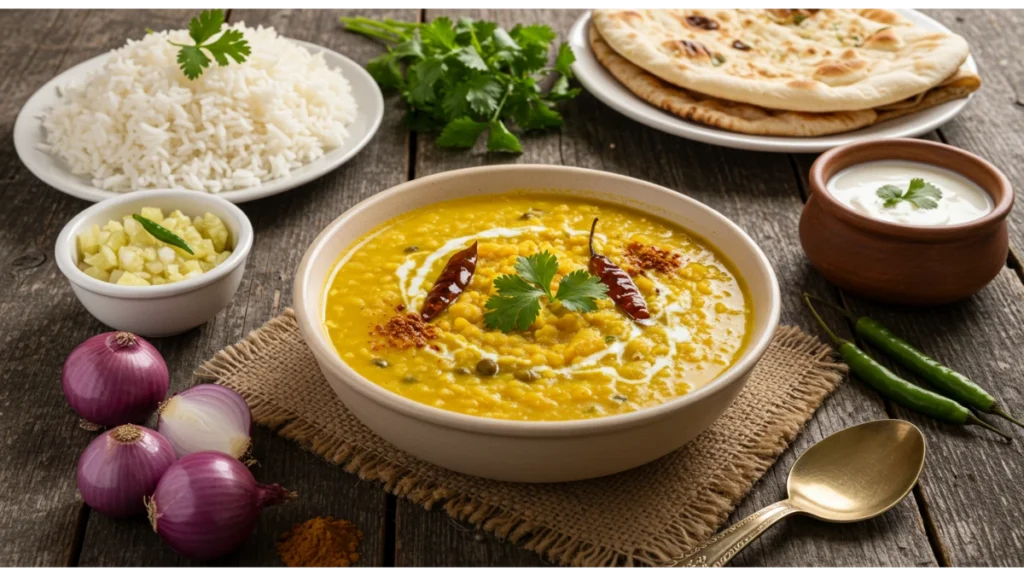
Ingredients:
- 1 cup lentils (toor dal or moong dal)
- 1 large onion, chopped
- 1-2 green chilies, slit
- 1 teaspoon ginger-garlic paste
- 1/2 teaspoon cumin seeds
- 1/2 teaspoon turmeric powder
- 1 teaspoon garam masala
- 2 tablespoons ghee or oil
- Salt to taste
- Fresh cilantro for garnish
Instructions:
- Rinse the lentils under cold water and boil them in a pot with 3 cups of water, turmeric powder, and salt until soft.
- In another skillet, warm ghee or oil over medium heat. Then, add ginger-garlic paste and green chilies, sautéing for another minute.
- Pour the cooked lentils into the skillet and stir well. Let it simmer for 5-10 minutes, adjusting the consistency with water as necessary.
- Top with garam masala and finish with fresh cilantro before serving.
Tips:
- Serve dal tadka with steamed rice or roti for a comforting meal. A squeeze of lemon juice can add a delightful tang.
- You can add a splash of water when reheating to restore the original texture.
Nutritional Value
| Recipe | Key Ingredients | Nutritional Benefits |
|---|---|---|
| Vegetable Biryani | Rice, vegetables | High in fiber, vitamins, and minerals |
| Palak Paneer | Spinach, paneer | Rich in iron, calcium, and protein |
| Chana Masala | Chickpeas, tomatoes | Excellent source of protein and fiber |
| Aloo Gobi | Potatoes, cauliflower | Good source of carbohydrates and vitamins |
| Dal Tadka | Lentils | High in protein and low in fat |
Benefits of Simple Indian Vegetarian Recipes
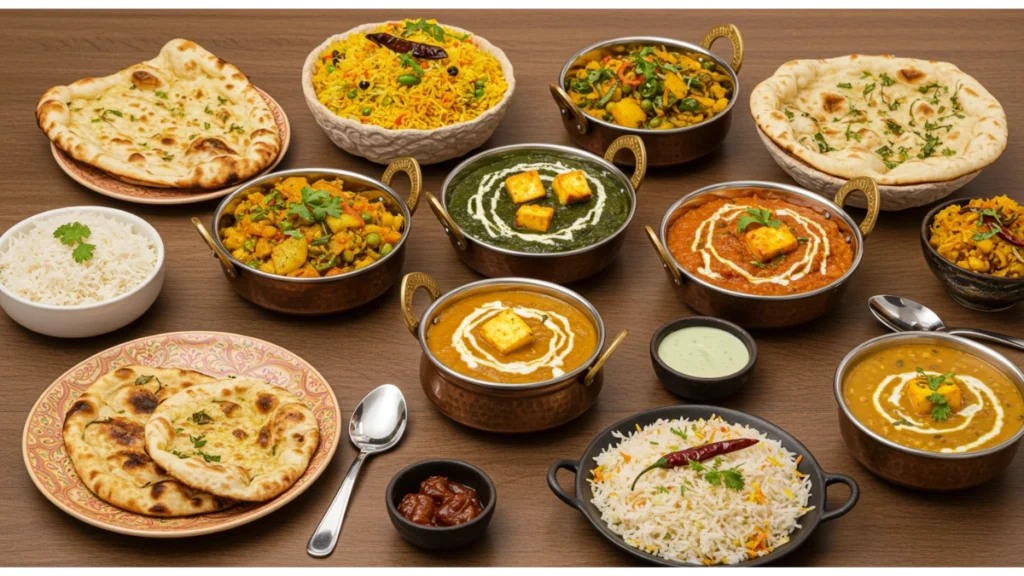
Simple Indian vegetarian recipes offer numerous benefits that make them an excellent choice for dinner:
- Nutritional Value:
These recipes are packed with essential nutrients, including proteins, vitamins, and minerals. The use of legumes, vegetables, and whole grains ensures a balanced diet. - Easy to Prepare:
Many Indian vegetarian recipes are straightforward and require minimal cooking skills. With simple ingredients and clear instructions, anyone can whip up a delicious meal. - Flavorful and Satisfying:
The combination of spices and fresh ingredients creates dishes that are bursting with flavor, making them satisfying and enjoyable to eat. - Versatility:
Indian vegetarian recipes can be easily adapted to suit different tastes and dietary preferences. You can modify ingredients, adjust spice levels, and experiment with flavors. - Cost-Effective:
Vegetarian meals are often more economical than meat-based dishes. Ingredients like lentils and seasonal vegetables are affordable and widely available. - Cultural Experience:
Cooking Indian vegetarian recipes allows you to explore the rich culinary traditions of India. It’s a wonderful way to connect with the culture and share it with family and friends.
Overcoming Challenges
When preparing Indian vegetarian recipes, you might face challenges such as unfamiliar spices or cooking techniques. Here are some effective strategies to tackle these challenges:
- Start Simple:
Begin with basic recipes that require fewer ingredients and spices. As you build your skills, start experimenting with more intricate recipes. - Learn About Spices:
Familiarize yourself with common Indian spices and their flavors. Understanding how to use them will enhance your cooking and allow you to experiment freely. - Use Fresh Ingredients:
Whenever possible, use fresh vegetables and herbs. Fresh ingredients significantly impact the flavor and texture of your dishes. - Watch Cooking Videos:
There are countless cooking tutorials available online that can guide you through techniques and recipes step by step. Visual aids can be incredibly helpful for beginners. - Practice Patience:
Cooking is an art that improves with practice. Don’t be discouraged by initial setbacks; each attempt will make you a better cook.
Future Trends in Indian Vegetarian Cooking
The trend towards plant-based diets is growing, and Indian vegetarian cuisine is well-positioned to meet this demand. Here are some insights into the future of Indian vegetarian cooking:
- Increased Popularity:
As more people adopt vegetarian and vegan lifestyles, the demand for innovative vegetarian recipes will rise. Indian cuisine, with its rich variety of vegetarian options, will likely gain even more recognition. - Fusion Cuisine:
Chefs and home cooks are increasingly experimenting with fusion recipes that combine traditional Indian flavors with other global cuisines. This trend will lead to exciting new dishes that appeal to a broader audience. - Health-Conscious Cooking:
With a growing focus on health and wellness, there will be an emphasis on using organic and locally sourced ingredients. Health-conscious adaptations of traditional recipes will become more common. - Sustainability:
As awareness of environmental issues increases, there will be a shift towards sustainable cooking practices. This includes reducing food waste and using seasonal ingredients. - Online Cooking Communities:
The rise of social media and online platforms will continue to foster communities where home cooks share their recipes, tips, and experiences. This will promote cultural exchange and inspire creativity in the kitchen.
Tips and Tricks Section
Here are some helpful tips and tricks to enhance your experience while preparing Indian vegetarian recipes:
- Preparation Tips:
- Chop vegetables in advance to save time during cooking.
- Soak lentils and beans overnight for quicker cooking.
- Ingredient Substitutions:
- Use tofu instead of paneer for a vegan option.
- Substitute ghee with olive oil for a healthier cooking fat.
- Flavor Enhancements:
- Experiment with different spices to create unique flavors.
- Add a splash of lemon juice or vinegar to brighten up your dishes.
- Presentation Matters:
- Garnish your dishes with fresh herbs or a drizzle of cream to enhance their visual appeal.
- Serve with colorful side dishes to create a vibrant plate.
- Storage Tips:
- Store leftovers in airtight containers to keep them fresh. Most Indian vegetarian dishes can be refrigerated for up to 3-4 days.
- When reheating, add a splash of water to restore the original consistency and prevent drying out.
- Batch Cooking:
- Prepare larger quantities of staple dishes like dal or curries, and freeze them in portions. This way, you can enjoy a homemade meal on busy days without much effort.
- Cooked rice can also be frozen in portions for quick meals.
- Experiment with Flavors:
- Try adding different vegetables to your curries and biryanis based on what’s in season or available in your pantry.
- Don’t hesitate to adjust spice levels according to your taste preferences; cooking is all about personalizing flavors.
- Cultural Exploration:
- Explore regional variations of Indian dishes. For instance, try making a South Indian sambar or a North Indian chole to experience the diversity of flavors.
- Attend cooking classes or workshops to learn traditional cooking techniques from experienced chefs.
Variations and Adaptations
One of the beautiful aspects of Indian vegetarian cooking is its adaptability. Here are some suggestions for variations and adaptations to suit different dietary needs:
- Gluten-Free Options:
- Many Indian dishes, such as dal and curries, are naturally gluten-free. Pair them with rice or gluten-free breads like besan chilla or dosa.
- Use gluten-free flours like chickpea flour or rice flour for making rotis or pancakes.
- Vegan Substitutions:
- Replace dairy products with plant-based alternatives. Use coconut milk in curries instead of cream, and cashew cream for a rich texture.
- For recipes that call for paneer, use tofu or tempeh as a protein-rich substitute.
- Low-Carb Variations:
- Substitute rice with cauliflower rice for a low-carb alternative. Simply pulse cauliflower florets in a food processor and sauté them lightly.
- Use zucchini noodles or spiralized vegetables in place of traditional pasta in Indian-inspired dishes.
- Kid-Friendly Adaptations:
- Adjust spice levels to cater to younger palates by reducing the amount of chili or using milder spices.
- Incorporate fun shapes and colors in vegetable preparations to make them more appealing to children.
- Meal Prep Friendly:
- Opt for one-pot meals like khichdi or biryani that can be made in larger quantities and stored for the week.
- Pre-chop vegetables and store them in the fridge to speed up the cooking process during busy weekdays.
FAQs Section
Here are some common questions regarding Indian vegetarian cooking, along with their answers:
- Can I use frozen vegetables in these recipes?
Yes, frozen vegetables can be a convenient option. They are often pre-washed and chopped, making them easy to use in curries and stir-fries. - How do I know when my lentils are cooked?
Lentils should be tender but not mushy. You can test them by tasting a few; they should hold their shape while being soft enough to easily mash. - What can I substitute for ghee?
If you prefer a vegan option, you can use vegetable oil, coconut oil, or olive oil as a substitute for ghee in recipes. - How can I make my dishes less spicy?
To reduce the heat, you can use fewer green chilies, remove the seeds from the chilies, or add dairy products like yogurt or cream to mellow the spice. - Is it necessary to soak lentils before cooking?
Soaking lentils can reduce cooking time and help with digestion. However, some lentils, like red lentils, do not require soaking. - How do I store leftover curries?
Allow the curry to cool completely before transferring it to an airtight container. Store it in the refrigerator for up to 4 days or freeze it for longer storage. - What are some good side dishes to serve with Indian vegetarian meals?
Popular sides include raita (yogurt sauce), papadum (crispy lentil wafers), pickles, and salads. These can enhance the meal and provide additional flavors.
Conclusion
In conclusion, simple Indian vegetarian recipes for dinner offer a delightful way to enjoy flavorful and nutritious meals. With easy-to-follow instructions and a variety of options, you can bring the essence of Indian cooking into your home. From the aromatic vegetable biryani to the comforting dal tadka, each dish is a celebration of vibrant flavors and wholesome ingredients.
Exploring Indian vegetarian cuisine not only enriches your culinary repertoire but also provides an opportunity to connect with a rich cultural tradition. Whether you are cooking for family, friends, or simply for yourself, these recipes will inspire you to create memorable dining experiences.
I encourage you to try these recipes and share your experiences with others. Cooking is a journey filled with creativity and love, and every meal prepared is a testament to the joy of sharing food. Don’t forget to experiment, adapt, and make these dishes your own. Happy cooking!

Simple Indian Vegetarian Recipes for Dinner
Ingredients
For Vegetable Biryani
- 2 cups basmati rice Thoroughly washed and soaked for 30 minutes
- 1 cup mixed vegetables (carrots, peas, beans, and potatoes)
- 1 large onion, thinly sliced
- 2 medium tomatoes, chopped
- 2-3 pieces green chilies, slit
- 1 teaspoon ginger-garlic paste
- 2-3 tablespoons biryani masala
- 1/4 cup fresh mint leaves, chopped
- 1/4 cup fresh cilantro, chopped
- 4 cups water
- 2 tablespoons ghee or oil
- to taste salt
For Palak Paneer
- 250 grams paneer, cubed
- 2 cups spinach leaves, washed and chopped
- 1 large onion, chopped
- 2 medium tomatoes, chopped
- 1 teaspoon ginger-garlic paste
- 1-2 green chilies, slit
- 1/2 teaspoon cumin seeds
- 1/2 teaspoon turmeric powder
- 1/2 teaspoon garam masala
- 2 tablespoons oil or ghee
- to taste salt
- optional fresh cream, for garnish
For Chana Masala
- 1 cup chickpeas, canned or soaked overnight and boiled
- 1 large onion, finely chopped
- 2 medium tomatoes, chopped
- 1-2 green chilies, slit
- 1 teaspoon ginger-garlic paste
- 1 teaspoon cumin seeds
- 1 teaspoon coriander powder
- 1/2 teaspoon cumin powder
- 1/2 teaspoon turmeric powder
- 1/2 teaspoon garam masala
- 2 tablespoons oil
- to taste salt
- fresh cilantro for garnish
For Aloo Gobi
- 2 medium potatoes, diced
- 1 small cauliflower, cut into florets
- 1 large onion, sliced
- 1 teaspoon ginger-garlic paste
- 1 teaspoon cumin seeds
- 1/2 teaspoon turmeric powder
- 1 teaspoon coriander powder
- 1/2 teaspoon garam masala
- 2 tablespoons oil
- to taste salt
- fresh cilantro for garnish
For Dal Tadka
- 1 cup lentils (toor dal or moong dal)
- 1 large onion, chopped
- 1-2 green chilies, slit
- 1 teaspoon ginger-garlic paste
- 1/2 teaspoon cumin seeds
- 1/2 teaspoon turmeric powder
- 1 teaspoon garam masala
- 2 tablespoons ghee or oil
- to taste salt
- fresh cilantro for garnish
Instructions
Preparation
- Wash and soak basmati rice for 30 minutes.
- Chop all vegetables, onions, tomatoes, and prepare spices as needed.
Cooking the Recipes
- For each recipe, follow respective instructions provided for the Vegetable Biryani, Palak Paneer, Chana Masala, Aloo Gobi, and Dal Tadka.

